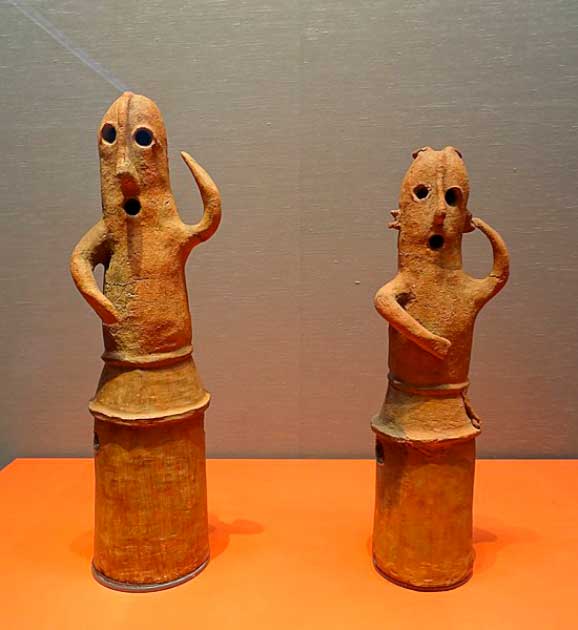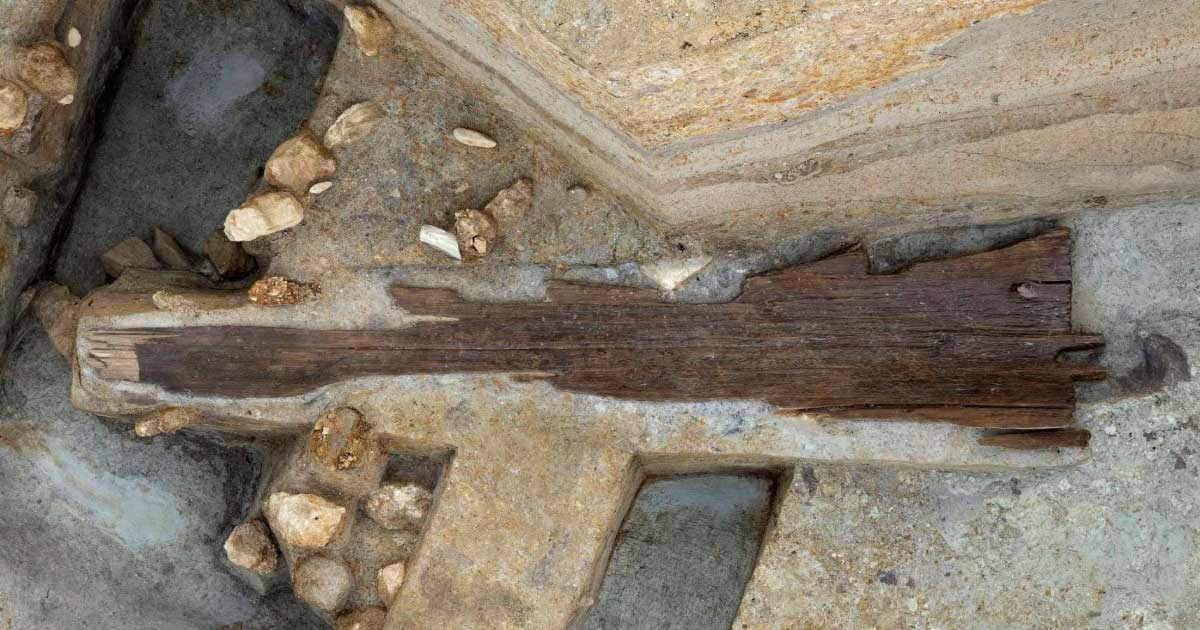Rare, Giant-Sized Haniwa Funerary Statue Found in Japan
Archaeologists excavating a burial mound at the Mozu-Furuichi Kofun Group, a UNESCO World Heritage Site in Osaka Prefecture in southern Japan, have found the remains of a rare wooden haniwa statue.
Haniwa statues are usually made of unglazed clay. Wooden examples are extremely uncommon. The recent find, at a height of 3.5 meters (11.5 feet), also has the distinction of being the tallest haniwa ever found, easily outstripping the 2.6-meter (8.5 feet)-tall Iwami-style specimen found at the Ohakayama Kofun in the city of Tenri in neighboring Nara Prefecture.
The statue is almost 30 inches (76 centimeters) wide at its widest point and around 3 inches (8 centimeters) thick, making it the largest overall haniwa to be found in Japan so far, according to the Japan Times. According to the education board of the city of Habikino, the haniwa was found during an excavation of a moat surrounding the 315-feet (96 meters)-long keyhole-shaped Minegazuka Kofun burial mound built in the late fifth century.

Reporter demonstrating the size of the haniwa statue. (ytv news / YouTube Screenshot)
Haniwa Statues - Rich Sources of Information for the Kofun Period
Haniwa are hollow funerary objects, Arkeonews reports. Haniwa were typically large, many nearly life-sized. Beginning as cylindrical, jar, or bell-shaped objects made by stacking coils of clay, haniwa evolved in a number of ways during the Kofun period (c. 250 to 600 AD).
- Workers Paving a Japanese Road Unearth Remarkable 1,500-Year-Old Armor and Sword
- Delving into the Depths of Japan’s Mysterious Tonkararin Tunnels
In the early fourth century, house-shaped haniwa were placed alongside cylindrical ones on top of the mounds. By the mid-fifth century, haniwa were shaped like objects (swords, shields, quivers, parasols), people (priests, warriors, maidens) and animals (horses, dogs, boars, ducks) and were lined up or arranged in clusters around the edges of the tombs, according to the History Blog. The arrangements may have had ritual significance.

Haniwa in dancing form, excavated from Nohara Tumulus, Kumagaya-shi, Saitama, Kofun period, 500s AD, ceramic. Tokyo National Museum. (Public Domain)
Haniwa provide important information about the Kofun period’s clothing, ornaments, hairstyles, weapons, tools, and architecture. They indicate that by around 250 AD, Japan had a strong state. This state is known by various names, one being the Yamato polity. It operated largely from the present-day Nara, Kyoto, and Osaka prefectures.
The Minegazuka Kofun Haniwa
The recently found statue is an Iwami-style haniwa, which “has only been found at 15 kofun tumuli in Japan so far”, an official of the Habikino education board has been quoted by Arkeonews as saying. “The haniwa is a very rare artifact as it is made of kōyamaki (Japanese umbrella pine), which was a type of wood favored by people in power at the time,” the official added.
According to Hiroaki Suzuki of the Nara Prefectural Government’s cultural property preservation division, “Wooden haniwa made out of kōyamaki, which can be logged in only a few areas in Japan, have only been found from kofun tumuli in the Kinki region and are extremely few in number.”

The Minegazuka Kofun ancient burial mound in Habikino, Osaka Prefecture. (HABIKINO BOARD OF EDUCATION / VIA KYODO)
The Mounded Tombs of the Mozu-Furuichi Kofun Group
The Mozu- Furuichi Kofun complex is located on a plateau above the Osaka plain and consists of 49 kofun (Japanese for old mounds) - large, mounded burial tombs. A rich source of information about Japanese society from the third to the sixth century AD, particularly the lifestyles of the elite, the Mozu- Furuichi Kofun group has been designated a UNESCO World Heritage Site.
- Ancient Trap Ideas to Protect Your Tomb or Catch Your Lunch
- Satellite Images Reveal Japanese Kofun Tombs all Aligned to Rising Sun
This group of 49 burial mounds, arranged in the two main Mozu and Furuichi clusters, has been chosen for the World Heritage site status from a total of 160,000 kofun in Japan as being the richest material representation of the period. The Mozu- Furuichi kofun are thought to house the dead from imperial and noble clans, and some are royal tombs or Ryobo. The kofun show that elaborate practices governed burial of the dead in Japan in the period and a sophisticated funerary system was in place.

Mozu-Furuichi kofun group. (TM / Adobe Stock)
They were built in a variety of shapes from scallop and square to circle, but were typically keyhole-shaped or zenp ken fun (“front squared, rear rounded tomb”). The square section formed the front while the rear chamber where the dead person or persons were interred was rounded. The kofun show Japan’s technical advancement in earthen constructions.
The earliest surviving keyhole tombs from the third century are to be found, however, in the neighboring Nara Prefecture, including Sakurai’s colossal Hashihaka kofun. It measures approximately 280 meters (918 feet) in length and 30 meters (98 feet) in height.
While haniwa statues tended to be large, many being life-sized, the recent find is remarkable for not only being giant-sized but also a rare wooden specimen. Archaeologists will study it in detail to understand its significance.
Top image: The rare wooden haniwa statue found in the Osaka Prefecture, Japan. Source: HABIKINO BOARD OF EDUCATION / VIA KYODO
By Sahir Pandey
References
Kayra, O. Archeologists unearth largest rare wooden “Haniwa” Statue in Japan. Available at: https://arkeonews.net/archeologists-unearth-largest-rare-wooden-haniwa-statue-in-japan/.
The History Blog. Tallest Haniwa Statue Ever Found Unearthed in Japan. Available at: http://www.thehistoryblog.com/archives/65890.
The Japan Times. Archaeologists unearth largest wooden 'haniwa' statue ever found in Japan. Available at: https://www.japantimes.co.jp/news/2022/12/09/national/habikino-osaka-largest-haniwa-statue-japan/.
UNESCO World Heritage Site List. Mozu-Furuichi Kofun Group: Mounded Tombs of Ancient Japan. Available at: https://whc.unesco.org/en/list/1593/.




















Comments
Probably the remains of the pre-Ice Age, Atlantean-era civilization of Japan upon the Atlantis event (circa 115k BC), adding the zero back to Plato’s timeline.
Nobody gets paid to tell the truth.